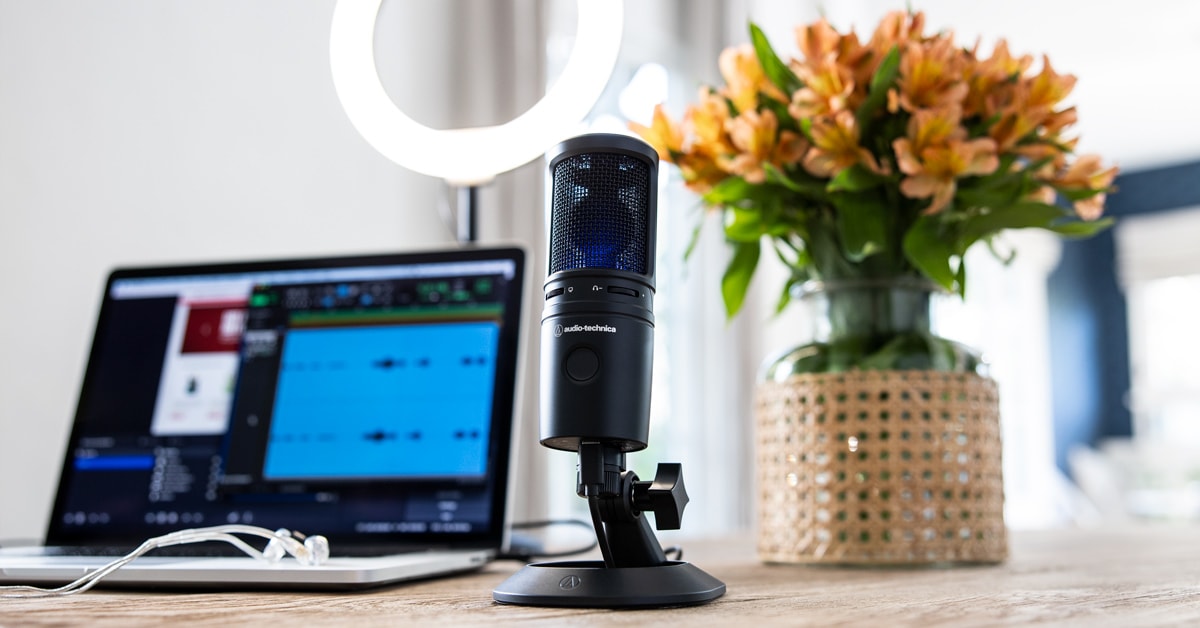What do the most popular and well-known social media influencers and content creators have in common today? Aside from compelling content, it's a quality, well-produced, great-looking, great-sounding livestream. Even with great information, if your audio isn't good or the video is trashy, or if your stream suffers from poor lighting, your audience will tend to wander off in search of something else. It's no longer enough to just stick your phone on a stand and go—the audience is coming to expect more. So, what can you do about it? If you're already livestreaming your music, whether it's a simple Instagram or TikTok stream, or a more-produced stream on Twitch, YouTube Live, Facebook, Vimeo or another service, we'll show you how to up your production values. So, get set, as we show you some basic gear that can up your streaming game, enabling you to have a stream that looks and sounds the way you want.
Mevo: A Graceful All-In-One Solution
Modularity for Versatility
Cameras
Lighting
Microphones
Audio Interfaces and Mixers
Monitoring
Encoders
Options
Software
Check Your Bandwidth
Mevo: A Graceful All-In-One Solution
If you like simple solutions to complex problems, the Logitech Mevo ecosystem may be just what you're looking for. The amazingly compact Mevo Start Live camera, available in a single pack or as a pack of three for multi-camera streams, uses ultra-high-resolution, high-dynamic-range (HDR) sensors and a versatile mobile app to simulate physical panning and zooming at full 1080p HD resolution, with AI features that can track faces and automatically adjust the shot on a single camera, or an "Auto-Director" feature on their multi-cam app that makes smart shot choices without you having to check the app while you're streaming. The camera also has a trio of integrated MEMS (micro-electro-mechanical systems) microphones for great sound field capture, plus the capability of adding an external microphone (see our section on microphones below) when you need one.

Pictured: Logitech Mevo Start Live Streaming Camera
There's more to the Mevo Smart Live than just the camera. A built-in encoder and high-speed Wi-Fi, plus the capacity to hard-wire connect to the internet with the optional PoE (Power over Ethernet) adapter, means the capability of streaming Full HD at up to 6GBps (gigabytes per second) wirelessly, or up to 15GBps hard-wired. This means that all you need is your phone and the camera system, and you're "on the air" from wherever you are. A strong feature here is that you can grow the system as your needs grow. Start with a single Mevo camera, then just add more and switch to the MultiCam app when your stream expands.
The phone apps also let you add custom graphics, mix an external audio source with the internal audio, and stream to multiple services at once. If you're looking for a compact, easy-to-use system with a ton of versatility, especially if you're just starting to explore the world of multi-camera streaming, the Mevo Smart Live is a great place to start leveling up. This system is also a great choice if it's just you doing the stream without a separate camera person or sound engineer to help out.
Modularity for Versatility
All-in-one solutions are great, but what if you want the flexibility that comes with a more modular system, or what if you already own some of the gear and just want to expand your capability? A modular system can add complexity, but it also adds a lot of versatility. In this section, we'll break down some of the á la carte options that will enable you to put together a streaming setup that's customized to your needs.
Cameras
Since livestreaming is a visual medium, let's start with a couple of camera choices, both from Zoom Corp. (not the teleconferencing company)—the Zoom Q2n-4K and the Zoom Q8n-4K. These related cameras offer up 4K video, streamed or recorded, and stellar stereo audio that's a descendant of Zoom's many award-winning handheld recording devices. Let's start with what they have in common.
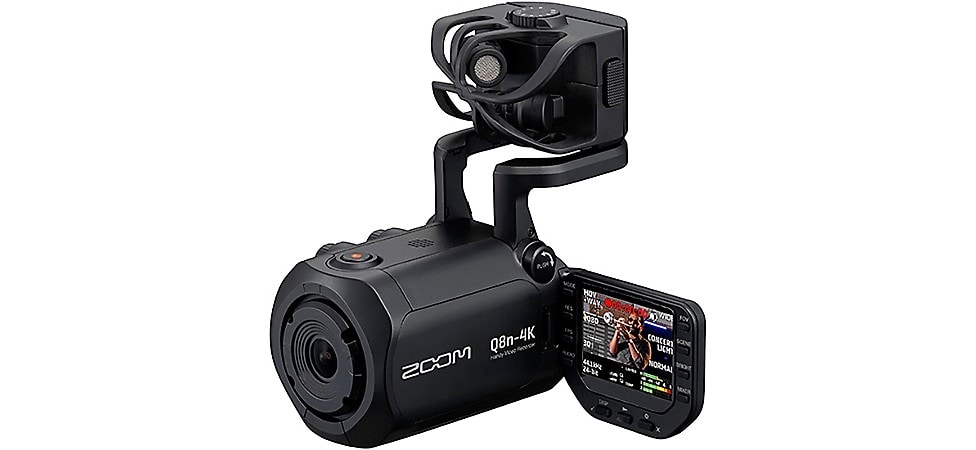
Pictured: Zoom Q8n-4K Ultra High Definition Handy Video Recorder
Both cameras offer the same camera engine with a 4K HDR sensor and 150° f2.8 wide-angle lens with five different field-of-view choices, ranging from wide to tele, so you can frame the shot you want easily. Multiple scenes offer everything from lighting adjustments (low light, stage lighting, outdoor, etc.) to special effects (sepia, black and white, monochrome). Both cameras have HDMI outs (see the section on hardware encoders below) or a direct USB connection, which also helps it double as a darn-good webcam. Output video resolution is selectable at 720p, 1080p or full 4K, as is video recording to an internal SD card. This last feature is handy if you want to stream in 1080p, but take the 4K recordings and edit out segments for distribution at the highest available resolution.
Where the Zoom Corp. cameras stand out is the audio quality, and this is also where the main differences between the two pop up. Both cameras use Zoom's X/Y cardioid condenser mic pair that handles SPL (sound pressure level) up to 125dB, with excellent stereo soundfield, and can record audio at up to 24-bit/96kHz. The Q2n-4K has an auxiliary unbalanced stereo in on a 3.5 mm (1/8") jack so you can connect an external mic. The internal mics are disabled when an external mic is connected, so you get one or the other. The Q8n-4K, on the other hand, has a pair of XLR inputs that are always available, so you can mix an external balanced mic or line level source with the onboard mics. This is especially useful if you want to use individual mics on people, but still want the sound of the room itself as part of the sound for the stream. But there's another important part of that video equation here.
Lighting
Lighting is a place where a lot of livestreams fall short. Things might be murky and indistinct or too bright and washed out. It's important to get the look right if you want to catch and hold an audience. So, before we talk about gear, a little lighting theory.
The standard method for lighting used for stage, film and video is the three-light method. This setup uses one light (the key light) to illuminate the performer's face, slightly from one side. Why to one side? Because you need a little shadow to keep features from flattening out as you'd get from a single light source directly in front of the performer. The second light (the fill light) is slightly less bright than the key light, and slightly on the other side of the performer. This softens the shadows caused by the key light. The third light (the backlight) is a light behind the performer. This helps add some depth to the set and keeps the performer from fading into the background. Generally, think of lighting as a triangle placed around the performers, with two points in front and one behind. That's the basics, though you always have the option to add accents elsewhere.

Pictured: Gator 10-Inch LED Desktop Ring Light Stand with Phone Holder and Compact Weighted Base
So, how do we get this setup done quickly and easily? A simple solution is to use LED ring lights for the front lights. You can start with the Gator 10" Desktop Ring Light which has an integrated universal phone mount if you're using a phone as a camera. Or, choose Gator's set of two height-adjustable stands, each with its own ring light, and you've got the key light and fill light covered. These ring lights have adjustable warmth settings (for the light temperature—you know, warm, cool, neutral) so you can tailor the look. For a backlight, you might want to add a little color, and the Venue Tetra 6 compact wash light, set on the floor and either bouncing off the rear wall or aimed at the back of your head for the popular "halo" effect, is a great, affordable choice. If you want to get really fancy, you can add a second wash light and Venue's Light Conductor DMX controller with a footswitch, and you can then change the background colors while you're streaming. Ooooooh, shiny!
Now that we've got you looking great, let's make sure the sound is right. On to our next category, your microphone.
Microphones
While built-in mics are a solid starting place, unless you've got a well-treated acoustic space, a mic at a distance can sometimes make dialog difficult to distinguish. Having dedicated mics that are close to the speaker(s) keeps the room reverberation at bay, and the "mud" at a minimum. The big question becomes, do you go wired or wireless? Here are options for both.
Let's start with the wired choice—the Audio-Technica AT-2020 USB-X. The 2020 USB-X is Audio-Technica’s latest generation USB condenser mic and features a class-compliant, plug’n’play USB-C connection. With AT’s popular 2020 cardioid capsule for solid, accurate sound, the 2020 USB-X is also loaded with features any livestreamer will appreciate, like a mute switch with an LED indicator, zero-latency monitoring with an on-mic volume control and the ability to blend the audio from your computer with the audio from the mic, bypassing the need for a separate mixer for single-mic liverstreams.
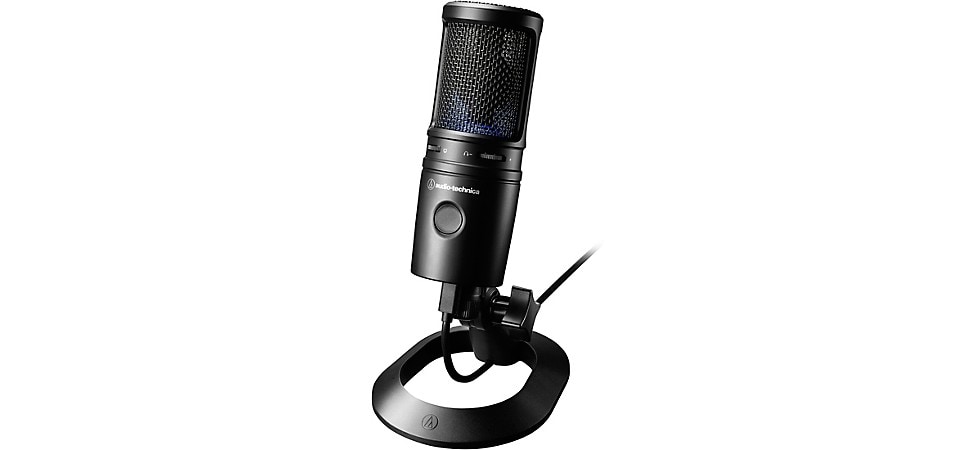
Pictured: Audio-Technica AT2020USB-X Cardioid Condenser USB Microphone
But what if you want to ditch the wires and wander unencumbered around your stream set, or do a demo of something where a desk mic would only get in the way? The Go II wireless mic from RØDE, available as a dual-channel receiver packaged with single or dual transmitters, is pretty much the streaming standard for wireless mics. A big part of that is its versatility. You can clip the small square transmitter directly to your shirt/blouse/overalls and use its built-in condenser mic, or connect any mini-TRS lavalier or headset mic, and use the transmitter as a belt pack. But the possibility of multiple mics speeds us along to the next category.
Audio Interfaces and Mixers
Once you've got more than one mic in play, you need a way to blend those audio sources together and get them into your computer. We've got three choices here, one for your phone, one for your tablet and one for your computer.
First, if your phone is the center of your stream, the Mackie M•Caster Live is a portable livestreaming mixer that, as Mackie says, "lets you connect all the things." By all the things, they mean a mic, headphones, your phone, your computer, a gaming headset, external studio monitors—pretty much anything that can be plugged into a 3.5 mm TRS or TRRS (the kind that plugs into a phone and carries both a headphone output and microphone input) jack. Replete with effects, EQ, vocal processing and more, it's pretty close to plug and play, something Mackie alludes to in their manual.

Pictured: Mackie M-Caster Live Portable Livestreaming Mixer
Next, aimed at the iPad user, is the Roland AeroCaster VRC-01, a combination audio interface and video switcher which is part of an entire streamcasting system. The AeroCaster system can wirelessly receive the video from up to four iOS or Android mobile devices loaded with Roland's camera app, while the VRC-01 can create an audio mix from a pair of mic/line XLR inputs and a stereo line in, and switch video. The iPad app adds effects and graphics, and even controls the phone cameras. It is, in effect, a compact professional broadcast studio scaled down to work with mobile devices.
Finally, the Focusrite Vocaster Two podcasting interface is aimed at streamers who have the video end of things sussed out but need some high-quality sound for smaller scale streamcasting. Compact and easy to use, the Vocaster Two, and its smaller sibling, the Vocaster One, brings Focusrite's legendary sound quality to bear on your livestream. With custom-designed vocal profiles to complement any voice, and versatile switching for easy enabling of remote or locals guests, the Vocaster Two is elegantly simple and makes sure that the sound from your stream is as impressive as the video.
Monitoring
At this point, you should have your outgoing video and audio under control. But what about the audio on set? For that, let's look at a couple of ways you can hear yourself, any guests and the audio you're sending out to the world.
Since you've got live mics, it's obvious that a set of speakers is not going to do the job here. We need to talk headphones and in-ear-monitors. We spend enough time on various streaming sites to know that there are still plenty of folks out there who are willing to sit in front of the camera with something like a gaming headset or a pair of standard headphones on while they're streaming. And that will work, but it's not the most professional look. Earphones or IEMs (in-ear monitors) are an excellent choice for a much cleaner look, especially if you've got great hair. We're big fans of the Shure SE425 Sound Isolating earphones, as they're almost invisible and have the superb sound you've come to expect from Shure.

Pictured: Shure SE425 Sound Isolating Earphones
What if you want to move around the set unencumbered by cables (which is why you got those RØDE wireless mics we mentioned before, right?) For that, let's stick with Shure and their PSM 300 wireless personal monitoring system. It's easy to configure and, once again, delivers excellent sound while providing you with the freedom to move from one part of your set to another, enabling you to provide more active and compelling content.
Encoders
As your livestream (and your audience) grows, you'll probably find that you want to grow the range of what you and your production can do. One way is to add extra video sources, new cameras for different angles, graphics from a computer or tablet, video playback from a media player or gaming system, etc. One of the easiest ways to do this is add hardware encoders that can take output from any HDMI source and convert it into a USB webcam form that your computer can easily deal with. It's also an essential component of a system that uses your computer, with software like the free, open-source Open Broadcast Software (OBS, and we'll come back to this in a moment), to assemble and control your livestream. One of the most accessible superior-quality encoders is the Roland UVC-1 USB video interface. It's compatible with current HDMI standards and supports up to 1080p at 60 frames per second for smooth, clear video. It's also fully integrated with Roland's V-series broadcast-quality video switchers.
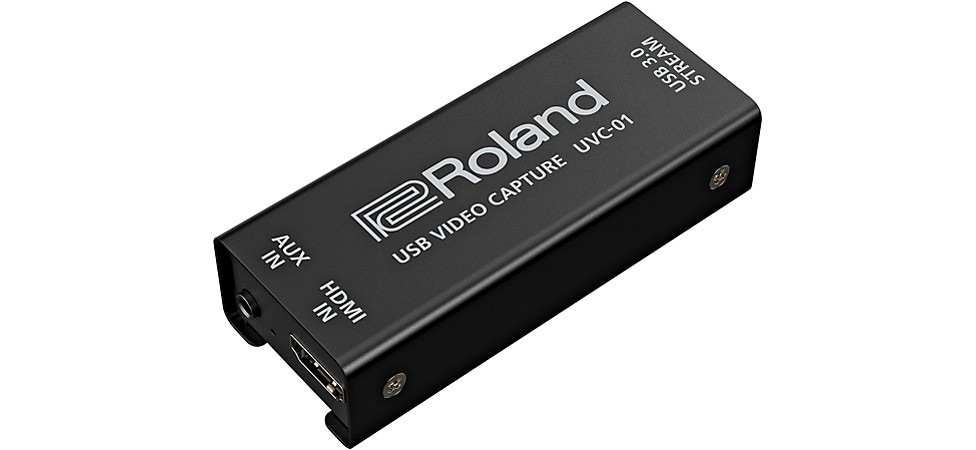
Pictured: Roland UVC-01 Encoder USB Video Interface
Options
As with any system you put together, there are always the odds and ends, bits and bobs that end up being needed to round things out. Here are a couple of things that, while not absolutely essential, will help make your livestream more engaging.
First, a green-screen kit will give you the ability to do what's known as chroma-keying (and you're probably familiar with this from the past couple of years' worth of tele-conferences), enabling the use of still photo or video backgrounds, so you can look as if you're standing in a majestic and wintry alpine setting while staying nice and warm at home. We recommend the On-Stage VSM3000 kit as an easy starting point. If you need a wall-size green screen, it doesn't really have to be green, just a color that's not going to appear on the set. Films use blue screen a lot, and your local fabric store may have bolts of cloth in appropriate colors that you can hand on stands designed for lighting bars, at less cost than you'd pay from a specialty video production house.
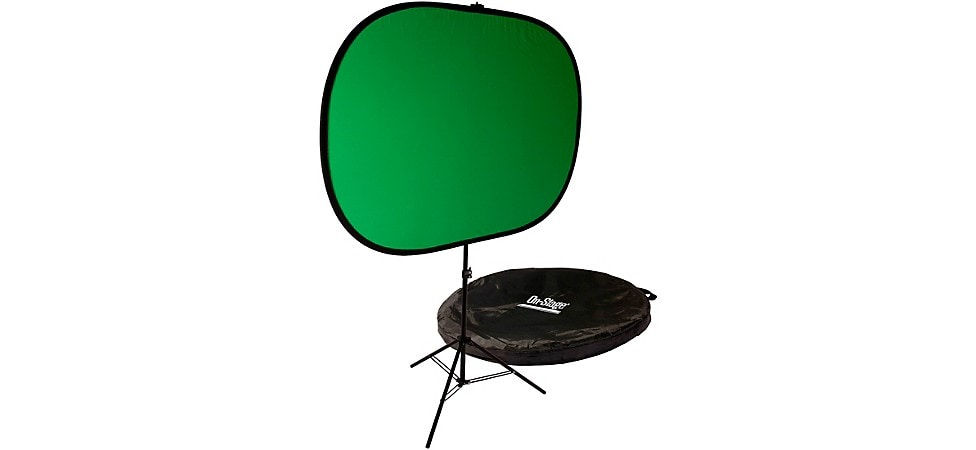
Pictured: On-Stage VSM3000 Green Screen Kit
Second, you'll need solid tripods to mount your cameras or phone holders if you want maximum versatility in camera placement. We're recommending the Benro BK15 mini tripod & selfie stick with remote for table/desktop use and the Benro Slim aluminum tripod for floor use.
Software
We mentioned streaming software above, and let's get back to that for a moment. While we don't sell any livestreaming software, there are a number of choices out there, some free open-source, like OBS Studio, others based on open-source, like StreamLab OBS, and some, like OWN3D Pro, are commercial choices. A lot of people swear by OBS (and some swear at it, but isn't that always the way), and, since it's free, it's a great place to dip your toe into the pool. Just know that the higher resolution and the more cameras and effects you want to use, you'll need an appropriately powerful computer, and there is a learning curve. We recommend that if you're thinking of taking this route, start simple and grow your system as your understanding expands.
Check Your Bandwidth
A quick note on bandwidth. You'll need it—a lot of it and at reliably high speeds. A 30 frame-per-second 1080p Full HD stream needs a minimum of a steady 5–6GBps (that's gigabytes, not gigabits) to be reliable. If you wanted to push the limits with a gorgeous 4K stream, you'd need 15GBps, minimum. This means that a hard-wired Ethernet connection is always going to be preferable, and if you absolutely have to use Wi-Fi, you need to make sure that it's not on a system that will be seeing other users while you're streaming. It's worth getting yourself a dedicated Wi-Fi router that's only used for your streaming setup. New 5G hotspots can provide sufficient bandwidth, if you're up to the expense of a dedicated streaming device, and you can talk with your mobile service provider about that.
Google and Ookla Speed Test are going to be your best friends in determining what the current available bandwidth is, and you'll want to be relatively conservative. Sometimes, especially if you're doing a remote stream, you may have to settle for a steady 720p stream to avoid annoying your audience with buffering and dropouts. But that's part of the challenge and part of the fun—making sure that your stream is steady, your audio is great and your content is compelling. While that last part is totally up to you, we hope that this article has helped you pull together the first two parts. Now get out there and start streaming. And, as always, if you've got questions or need more help, hit up our Gear Advisers in-store or online for answers and solutions.




